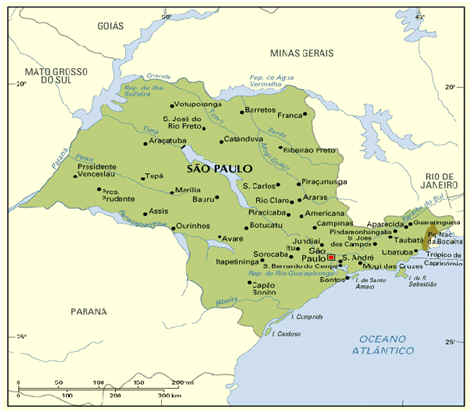|
Sao Paulo
City Facts:
Founded by Jesuits in 1554 and
entered commerce world through coffee plantation and exports.
30% of Brazilian GNP is derived
from this metropolitan city.
Population:
near 11 million
BRIC (Brazil, Russia, India,
China) – one of emerging markets slowly rising to global their
information technology
“Business Hub of Latin
America”


Development
CPQD was created in 1976 as a center for research and development for
Telebras the state which monopolized public telecommunication services.
A technological park, which comprises of seventeen companies are housed
together to adopt the concept of information cluster by sharing their
ideas for innovative technology.
With the privatization of Telebras in 1998, it became a private
foundation, but is still partially funded by the government and partners
with private companies to develop technology that the Brazilian state
deems beneficial to the public good.
The government funds research and development expenses and then arranges
technology transfers to private companies who develop the technology
commercially.
There is a closed relationship, however some companies send employees to
work for CPQD.
Advantages:
The technological park unveils the plethora of knowledge sharing that
engages various companies which furthers the prosperity of the entity
itself in terms of profitability and growth. This encourages smaller
corporations to interact with one another, which creates innovative
ideas and invites more projects developments amongst the company itself
and further progression to enhance the idea of globalization.
Their willingness to open their products with other nations can further
expand their park environment.
Disadvantage:
With such a highly
concentration of technological companies may deter their growth as it
can hinder globalization and for CPQD to reach out to other emerging
Brazilian companies outside their scope.
Financial
Their
revenue (73 per cent) comprises from IT services and innovative products
provided to other International corporations such as LG.
Has
competitive advantage when marketing out to the private sector to aid
funding in their future projects. CPQD had a useful marketing
presentation where it entails the history and growth of their
corporation. This encourages any potential to deduce the robust and
efficient format structure of CDQD.
The institution practices a roadmap to support clients in directing and
carrying out technology transactions and application of
business models, primarily focused on electricity. There is a heavy
emphasis to develop and use technology to support electrical
infrastructure. For example, use of electronic meters and sensors. CPQD
supports monitoring the expansion of broadband technology.
The government founded CPQD originally as a center to serve Telebras the
state monopoly on telecommunications services. Technological development
to create solutions that advance governmental development initiatives
like digital inclusion and educational initiatives is imperative.
The structure of the site presents a
very robust group of several corporations working with one another which
entails more projects and the ability for company’s within to invest
in each other’s new products.
Disadvantage:
The cluster of the companies are rarely dependent on government to fund
their projects which in some cases may hinder when they are try to
market their products internationally as Brazil are comprised of several
rules and regulations.
Challenges
Developing new partnerships with private companies to develop
commercially viable technology
The language barrier in communicating with customers in foreign markets
and marketing to international clients
Developing new technology for the infrastructure that currently exists
in Brazil for social inclusion instead of exclusively modern business
and consumer environments
Resources
Advanced infrastructure
They have relationships with 95 universities
Human user testing
Operational optimization: Partnership with Google
Efficiency with technology in remote locations
Technological park of 360,000 sq. m. and planning to expand
Administrative Issues
In order to take part of the technological park, one has to pay
royalties as well as provide ideas for CPQD to research.
Membership for the "country club" in the park
Providing services only to private schools
1|2|3 |



